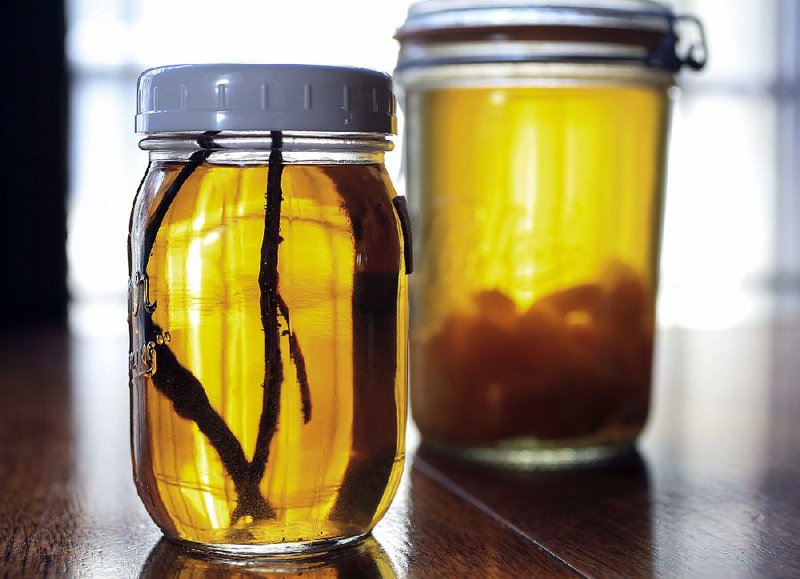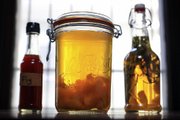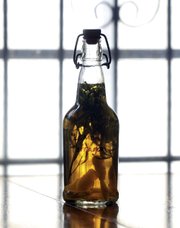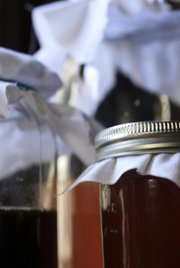It feels a lot like alchemy. The transformation is remarkable. Magical even.
In glass jars, alcohol, water, sugar and usually discarded bits of a piece of fruit -- tough, spiky skin and the inedible, coarse, fibrous core -- combine with time to create something sharp, flavorful, acidic.
Vinegar.
It is one of those rare instances when you can literally pull something out of the air. In this case, acetobacter bacteria, without which there could be no vinegar. The microorganisms oxidize organic compounds -- fruit and sugar in this case -- into acetic acid. Acetic acid is the essence of vinegar.
And you can make it at home. Well, most kinds anyway. Some vinegars -- balsamic and sherry -- should be left to the experts.
The easiest way to make vinegar at home is to use a starter. A vinegar starter is simply a piece of a blob called a mother, or as Harry Rosenblum describes it in Vinegar Revival: "a collection of slimy cellulose that forms at the intersection of the base liquid and the air." Mothers are available online, or you can use a bit of raw vinegar, such as Bragg apple cider vinegar.
Making vinegar completely from scratch -- without the aid of a mother or starter -- is possible, but the process takes longer and there are more variables.
The easiest way, if you don't have access to a mother, is to use the raw vinegar as a starter. I had good success with this method.
But few culinary accomplishments top the pride one feels upon discovering she has grown a mother.
I think my husband thought I had lost my mind when he heard me exclaim repeatedly "I have a mother! I have a mother!" one afternoon.
That moment made the weeks of living with swarms of fruit flies and the stench of fermenting fruit permeating every room on the first floor of our house worth it.
The real reward is difference in flavor. Homemade vinegar is different every time. And that's part of the beauty.
You don't have to fill your house with funky smells to enjoy gourmet vinegar. With a little time, good quality store-bought vinegar and a few aromatics, it's easy to make infused vinegar at home.
There are two basic methods for infusing vinegar. The simplest is to combine the vinegar and aromatics in a sanitized jar with a lid and leave it in a cool, dark place for 2 to 3 weeks. When it's ready, strain (discarding the aromatics) and bottle as desired.
The other method speeds the process. Place the vinegar in a saucepan and heat to a boil. Add aromatics, remove from heat and let cool to room temperature. The vinegar can be used immediately or, for a stronger flavor, left to infuse for 1 to 2 weeks. Strain and bottle as desired.
Tips
• Bruised or overripe fruit is OK, but don't use any moldy or rotten fruit.
• 2 tablespoons to 1/2 cup raw vinegar can be used to jump-start homemade vinegar instead of using a mother.
• Homemade vinegar is best used in cooking and making vinaigrettes. It can be used in refrigerator and freezer pickles, but because it can have inconsistent acidity isn't a safe option for traditional home canning.
• Save the "mother" for use in future batches of the same or similar kind.
• Some people believe there are health benefits (no large scale studies have backed up these claims) in consuming raw vinegar, but food safety experts recommend heating the finished vinegar to 140 to 150 degrees for 30 minutes to
pasteurize it for long-term storage. Pasteurized vinegar will keep indefinitely at room temperature out of direct sunlight. However, be sure to remove the mother before pasteurization as the heat will kill it, rendering it useless for future batches.
For further reading:
• The Incredible Secrets of Vinegar: The Quintessential Guide to the History, Lore, Varieties, and Healthful Benefits of Vinegar by Marie Nadine Antol
• Making and Using Vinegar: Recipes That Celebrate Vinegar's Versatility by Bill Collins
• Mastering Fermentation: Recipes for Making and Cooking With Fermented Foods by Mary Karlin
• Vinegar Revival: Artisinal Recipes for Brightening Dishes and Drinks With Homemade Vinegars by Harry Rosenblum
• ucfoodsafety.ucdavis.edu/files/192135.pdf
Apple or Pear Scrap Vinegar
1 1/2 pounds organic apple or pear peels and cores
1/4 cup unrefined granulated sugar
4 cups filtered water
2 to 4 tablespoons raw, unfiltered apple cider vinegar such as Bragg
Place the apple or pear scraps in a large glass jar or ceramic or glass crock or bowl.
Stir the sugar and water together until sugar dissolves. Pour sugar water over fruit, being sure to use enough liquid to cover the scraps. They will likely float to the top, and this is OK. Add apple cider vinegar.
Cover the container with several layers of cheesecloth or a dishtowel and leave at room temperature (65 degrees to 80 degrees) out of direct sunlight for 3 to 4 weeks, stirring once or twice a day. The mixture will bubble and froth -- this is good. Check regularly for mold. If any mold is visible, skim it off. If it comes back, throw the batch out and start over. After 3 to 4 weeks, you should have a mother -- it will start out as a smooth film across the surface of the liquid; as it grows it will become thicker and rubbery -- and the mixture should smell like vinegar. After 8 weeks, taste the vinegar (place a few drops on a piece of white bread to cut the bite and avoiding burning your mouth if it is too acidic). Check and taste every week until it is to your liking. This process could take longer, depending on the temperature, humidity and other factors of your environment. Strain the mixture into a bottle to use immediately or let it "age" for up to a year. Reserve the mother for your next batch, or give some to a friend.
Makes about 2 cups vinegar.
Recipe adapted from offthegridnews.com and foodpreservation.about.com
Small Batch Wine Vinegar
1 (750-mL) bottle good red, white or rose wine
Filtered water
1/2 cup vinegar mother OR live raw vinegar
Pour wine into a half-gallon jar with a tight-fitting lid. Seal jar and shake well to aerate. Add water until jar is 3/4 full. Add the mother or live raw vinegar. Cover the mouth of the jar with cheesecloth and secure with a rubber band. Place jar in a dark cupboard or corner at room temperature (65 to 80 degrees) for 3 to 4 weeks, checking regularly for mold. If any mold is visible, skim it off. If it comes back, throw the batch out and start over. After 3 to 4 weeks, you should have a mother -- it will start out as a smooth film across the surface of the liquid; as it grows it will become thicker and rubbery -- and the mixture should smell like vinegar. After 8 weeks, taste the vinegar (place a few drops on a piece of white bread to cut the bite and avoiding burning your mouth if it is too acidic). Check and taste every week until it is to your liking. This process may take longer, depending on the temperature, humidity and other factors of your environment. Strain the mixture into a bottle to use immediately or let it "age" for up to a year. Reserve the mother for your next batch, or give some to a friend.
Makes about 11/2 quarts.
Variation: For rice wine vinegar, substitute sake for the wine.
Recipe adapted from Vinegar Revival by Harry Rosenblum
Malt Vinegar
2 (12-ounce) bottles amber or dark beer such as brown ale or porter (9 percent alcohol or less by volume)
1/2 cup vinegar mother OR live raw vinegar
Pour beer into a 1/2-gallon jar and add the mother or live raw vinegar. Cover the mouth of the jar with cheesecloth and secure with a rubber band. Place jar in a dark cupboard or corner at room temperature (65 to 80 degrees) for 3 to 4 weeks, checking regularly for mold. If any mold is visible, skim it off. If it comes back, throw the batch out and start over. After 3 to 4 weeks, you should have a mother -- it will start out as a smooth film across the surface of the liquid; as it grows it will become thicker and rubbery -- and the mixture should smell like vinegar. After 8 weeks, taste the vinegar (place a few drops on a piece of white bread to cut the bite and avoiding burning your mouth if it is too acidic). Check and taste every week until it is to your liking. This process may take longer, depending on the temperature, humidity and other factors of your environment. Strain the mixture into a bottle to use immediately or let it "age" for up to a year. Reserve the mother for your next batch, or give some to a friend.
Makes about 11/2 quarts.
Variation: For apple cider vinegar use hard apple cider or fresh pressed apple cider in place of the beer.
Recipe adapted from Vinegar Revival by Harry Rosenblum
This vinegar takes the longest of all the kinds I tried. It also takes fortitude. Because no starter is used, the pineapple and sugar must ferment into alcohol before the process can begin. The mixture bubbles and changes color. This is normal. Skim off and discard any foam that forms. However, if the mixture smells putrid, throw it out and begin again.
Pineapple Vinegar
Skin and core from 1 fresh pineapple
1/2 cup unrefined granulated sugar PLUS more as needed
8 cups filtered water
Place the pineapple skin and core in a large glass jar.
Stir together the 1/2 cup sugar and water until the sugar is dissolved. Pour sugar water over pineapple scraps. Cover the jar with several layers of cheesecloth and secure cloth with a rubber band. Place jar in a dark place such as a seldom-opened kitchen cabinet and leave for 2 weeks at room temperature (65 degrees to 80 degrees). After two weeks, add 2 tablespoons of sugar and stir well. Feed mixture every two weeks for a total of 6 weeks or until a "mother" forms. After the mother appears, taste mixture and if it is to your liking, strain into bottles and use. If not to your liking, continue feeding 2 tablespoons of sugar every two weeks until desired flavor is reached. Depending on the temperature of your house and the desired flavor, the whole process can take anywhere from 6 weeks to 6 months.
Makes about 11/2 cups vinegar.
Recipe adapted from Mastering Fermentation: Recipes for Making and Cooking With Fermented Foods by Mary Karlin
This orange-infused vinegar makes a delicious vinaigrette or acid in a marinade for pork or beef.
Orange-Infused Vinegar
4 cups white-wine vinegar
Zest of 4 to 6 oranges
3 tablespoons sugar
No-cook method: Combine vinegar, orange zest and sugar in a large, lidded glass jar. Seal and place in a dark cupboard or pantry for 2 to 3 weeks. Strain, discarding solids, into bottles.
Fast method: Place the vinegar in a small saucepan. Bring to a boil. Stir in orange zest and sugar. Remove from heat and let cool to room temperature. The vinegar can be used immediately or, for a stronger flavor, left to infuse for 1 to 2 weeks. Strain and bottle as desired.
Makes about 4 cups.
Recipe adapted from Vinegar Revival by Harry Rosenblum
Vanilla-Infused Vinegar
1 vanilla bean (see note)
2 cups apple cider vinegar or white-wine vinegar
Cut the vanilla bean in half lengthwise and place it in a pint jar with a tight-fitting lid. Pour in vinegar. Close lid. Shake jar daily for at least 1 week and up to 4 weeks. When desired flavor is reached, remove the vanilla bean from the vinegar. Using the tip of a chef's knife, scrape the tiny seeds from the bean. Return the seeds to the vinegar. Pour mixture into a clean, narrow-mouth bottle with a lid or cork closure.
Makes about 2 cups.
Note: Be sure to use a vanilla bean that is still supple. Dried, brittle beans will not impart as much flavor.
Lemon-Tarragon Vinegar
2 cups cider vinegar or white-wine vinegar
Zest of 1 lemon
4 sprigs fresh tarragon
No-cook method: Combine vinegar, zest and tarragon in a large, lidded glass jar. Seal and place in a dark cupboard or pantry for 2 to 3 weeks. Strain, discarding solids, into bottles.
Fast method: Place the vinegar in a small saucepan. Bring to a boil. Stir in zest and tarragon. Remove from heat and let cool to room temperature. The vinegar can be used immediately or, for a stronger flavor, left to infuse for 1 to 2 weeks. Strain and bottle as desired.
Makes about 2 cups.
Fig-Infused Vinegar
1 ½ cups white-wine vinegar
1 cup quartered dried figs
In a small saucepan, combine the vinegar and figs. Bring to a simmer over medium-low heat. Reduce heat to low and simmer, covered, for 10 minutes. Remove from heat and let steep, 1 to 3 hours (the longer it steeps, the more fig flavor it will have). Strain through a fine-mesh sieve or cheesecloth into a sterilized glass bottle or jar.
Makes about 1 cup.
Recipe adapted from Homemade Condiments: Artisan Recipes Using Fresh, Natural Ingredients by Jessica Harlan
Food on 09/27/2017



